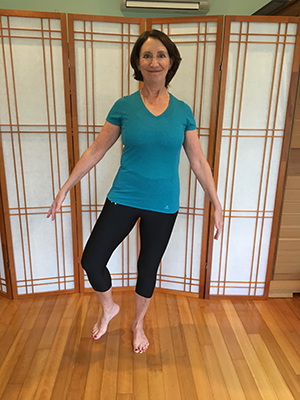Even though the body’s process for maintaining balance is very complex, there are 3 main systems that work together to keep you upright.
- Visual system: your vision helps you see where your body is in relationship to your environment
- Vestibular system: Inside your inner ear you have vestibular structures that inform the brain about changes in the head positions and body movements.
- Proprioception system: Your muscles, tendons and joints have special sensors called proprioceptors which help provide your brain with information on movement and position of your body parts.
Using the feedback of these 3 systems, the brain sends messages to your muscles to make adjustments to your body position in order to maintain balance and coordination. If any of these systems isn’t working correctly, it can increase your risk of falling. Other risk factors that contribute to falling are poor posture and muscle weakness, especially weakness in the muscles of the trunk, hips and ankles.
An effective balance training program includes exercises that integrates all these systems. By challenging these systems, along with strengthening your muscles and improving posture, you can improve your balance and decrease your risk of falling.
effective balance training program?
- Combine challenge with safety: Perform exercises near a wall, counter, desk, or firm chair so you have something to grab onto if you lose your balance…which you should! If the exercise isn’t challenging, it isn’t progressing your balance.
- Lose the shoes: First you need to ditch the shoes and perform balance activities in bare feet. Your feet are covered with proprioceptors and provide abundant feedback to your brain as to your body’s position. Barefoot balance activities also help to strengthen the muscles of the foot and ankle which will add to your stability.
- Add movement for maximum benefit: Moving your head while performing balance activities can stimulate the vestibular organs and adding in arm and leg movements improves reaction time and coordination of all three systems.
- Soften up the surface: changing the surface from firm floorings to standing on a pillow, a soft mat or a balance board will further challenge balance and strength simultaneously. Performing balance exercises on an unstable surface provides even greater proprioceptive training and strengthens muscle of the trunk and lower legs.
- On a firm surface, standing tall with your abdominal muscles tight
- First stand on your dominant leg with your other leg lifted and slightly bent at the hip and knee and positioned away from the standing leg
- Work up to holding this position for 20 seconds on each leg
- Challenge yourself by trying to hold this position with your eyes closed

Once you get good with the static single leg balance, progress to dynamic stability exercise to enhance the challenge to your visual, vestibular and proprioception systems.
Dynamic Balance exercises
While standing on one leg with good posture and abdominal muscles tight, move your arms back and forth in a running motion. Perform for 20-30 seconds.

Incorporate larger arm movements as if you are swimming the freestyle, then reverse arm direction and swim the backstroke.
Perform each for 20-30 seconds, switch legs.

Further engage your vestibular and visual system by adding in head turns. While standing on one leg, slowly and gently turn your head side to side at the rate of 1 movement per second. Head movements should be in a comfortable range and not cause neck pain.
Perform for 10-20 seconds

Next you can add lower leg movements. While standing on one leg, reach the other leg out to the front, side and then the back, initially touching your toe for balance if needed. You can increase the challenge of this exercise by performing a min squat with the leg movements. With this movement you can also add in arm and head movements as above.



If you are unable to stand safely on one leg, start by performing all the above exercises with your feet together and then progress to performing the exercises in a staggered stance.
As we move through life, our balance is challenged on a daily basis…whether you know it or not. The change in surfaces that we walk on, finding our way to the bathroom in the dark of night, turning your head to look to see if a car is coming as you walk across a street or a parking lot. Incorporating balance training into your daily exercise program will help you meet daily balance challenges, improve your stability and prevent falls. If you want to prevent fractures, we need to prevent falls!
Contact me to find out more ways you can protect your bones from fracturing! Susan@nurturedbones.com






